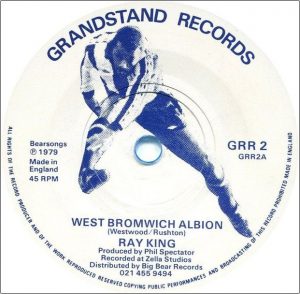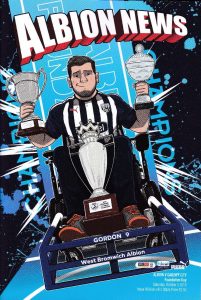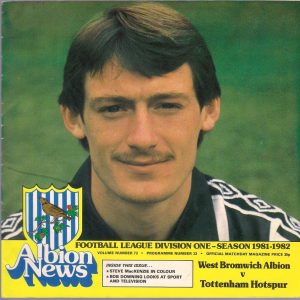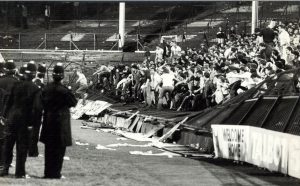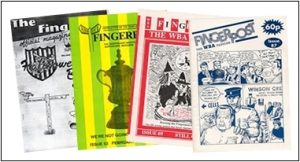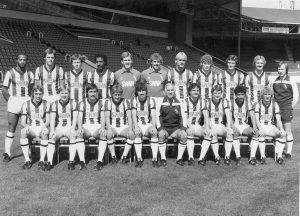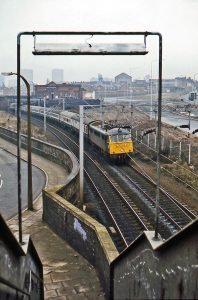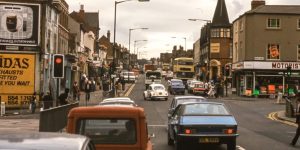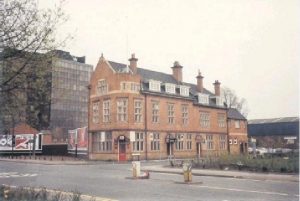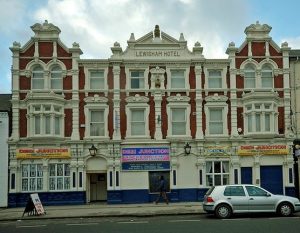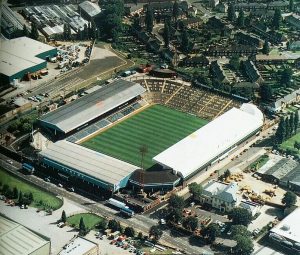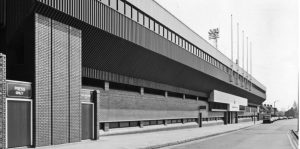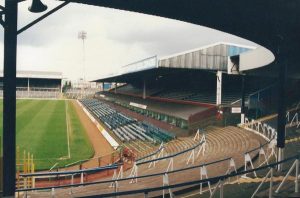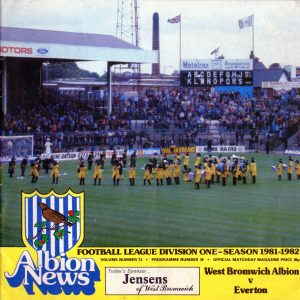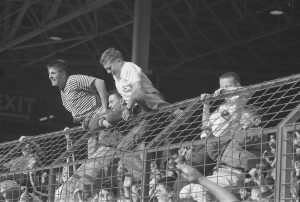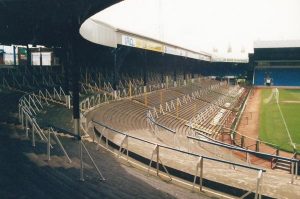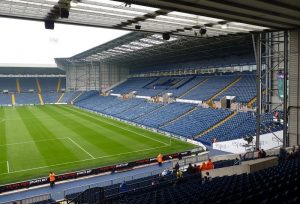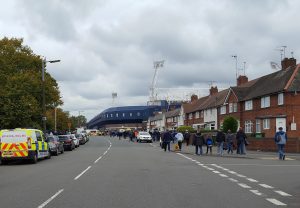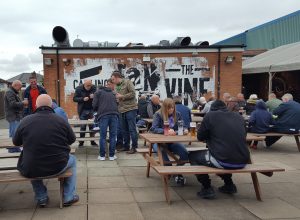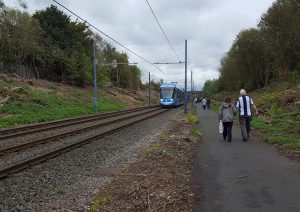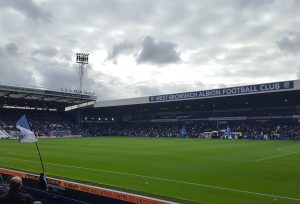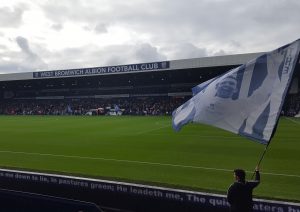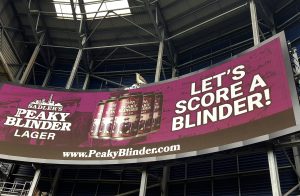West Bromwich Albion 4 Cardiff City 2
Championship
Saturday 5 October 2019
The context
We’d been planning a trip to Orient today, and got so far as arranging where to meet and park before Kieran helpfully pointed out that Orient weren’t playing at home. As a hasty alternative this game was both convenient to get to and – more importantly – actually taking place.
I’ve seen a lot of football here. It’s a story that started with admiring Albion’s style from afar as a callow youth and morphed into begging, borrowing or blagging a way into The Hawthorns every other week when my family moved to the Midlands in the early Eighties. I then found myself living in Dudley at the back end of the decade and held a season ticket through the miserable tail-end of the team’s long decline into the Third Division, the surreal muppetry of Bobby Gould’s reign and their eventual resurgence under Ossie Ardiles and Keith Burkinshaw.
John had been once, in 1987, “with a mate”. I suggested that whoever it was couldn’t have been much of a mate if he took him to watch West Brom when Ron Saunders was in charge.
The history
Many grounds in 1982 had more than a little faded glory about them. The Hawthorns too was haunted by ghosts of more successful times, and the long walk from Rolfe Street station took you on a post-apocalyptic journey past derelict factory sites and rubble-strewn waste ground. Carrier bags rustled forlornly on barbed wire, an inevitable chilly wind blew litter in your face and there was spidery white football grafitti everywhere – more so after May, when a famously anarchic evening saw Albion effectively consign Leeds to Division Two amidst scenes of vandalism rarely matched at any football match before or since.
Eventually you crossed a bridge over a railway line. At one time this had connected Snow Hill in Birmingham with the main Euston-Glasgow route at Oldbury, but it was now used only by the occasional cement train. A cutting either side held the overgrown remains of the Hawthorns Halt. Opened in 1931 to coincide with Albion’s promotion to Division One, this station – although basic – had four substantial platforms. Three were on the town centre side of the bridge and the fourth where the Metro station is today.
Railway enthusiasts can read the whole interesting story here:
Disused Stations: The Hawthorns Halt
Notes: The construction of a railway north from Birmingham Snow Hill to Priestfield, where it would meet the Oxford, Worcester & Wolverhampton Railway (OW&WR) was authorised on 3 August 1846 to the Birmingham, Wolverhampton & Dudley Railway (BW&DR).
The next landmark was the Halfords Lane Throstle Club, which stood opposite Albion Road on land now occupied by the Academy building. This was a worn survivor of dozens of Throstle Clubs that once thrived right across the Black Country. The first opened in 1965 next to the Woodman pub, and membership of the official supporters’ association burgeoned following the team’s success in the mid Sixties. Over the next few years it seemed Albion stars were constantly being photographed pulling the first pint in some new premises or another,
One of these clubs bridged the perpetual summer of the 1968 FA Cup win and the Narnia-like winter of Saunders’ dour tenure. The Fingerpost fanzine and its more punchy successor Grorty Dick grew out of the Halesowen branch, as did the famous Strollers football team. These two initiatives projected a hugely positive image in an era when football fans were not well thought of. At the same time the branch’s legendary Dave Holloway created the aptly-named Mammoth Tours to provide safe away travel at a time when the team desperately needed support.
All this was some way in the future during an eventful 1981-82 season in which Ronnie Allen’s side lost two Cup semi-finals and only avoided relegation by winning a couple of desperate six-pointers in the final few weeks. For all these ups and downs it was a high-water mark of sorts. Life was only going to be harder now Bryan Robson and Remi Moses had followed the treacherous Atkinson out of the door, while Cyrille Regis and Brendon Batson would both leave within two years and the last remnants of Big Ron’s flamboyance with them. But the team still ran out to Ray King’s classic calypso “You gotta go man go for Ron Atkinson”, and for a short while yet some of the magic would endure. I’ve always thanked my lucky stars I caught it just in time.
The journey
An electric rattler was the preferred mode of transport for young rips back in the day. It could let you in for a nervous afternoon if Man U or the London clubs were in town, but mingling with away fans deterred the ticket collector. This route took you past, and often into, three pubs – the Cock Inn (hehe), the Waggon & Horses and the Old House at Home. Their door policies became progressively less tolerant as you neared the away end. Only the Waggon survives. The Cock is now the Albion Foundation and the Old House site lies underneath the Metro car park.
In later years I came to know and love the bus routes past the ground. These ran between Birmingham and Wolverhampton (the 78/79) and Dudley (the 74). Each had its charms, not least the pedestrian crawl along a two-mile stretch through Handsworth and Lozells which in the early to mid-80s seemed often to be teetering on the edge of a full-blown riot. On days like those being accosted by rival fans could feel the least of your worries, which certainly wasn’t the case after one Black Country derby when the back seat of a 74 was removed on West Bromwich High Street and thrown through the side windows at some passing Wolves supporters.
Bus pubs included the Woodman and the Hawthorns Hotel, right outside the turnstiles and now a car park and a branch of Greggs respectively, while beyond the M5 were the Lewisham and the Three Mile Oak. You needed your wits about you here. Both had their share of rum patrons and bad lads (not always match-goers) lying in wait for visiting fans foolish or knowing enough to park on the wrong side of the motorway. A fracas on Roebuck Street outside the Three Mile Oak one grey Saturday in 1989 saw an innocent Everton fan lose an eye when he and his pals misjudged the best place to park their minibus.
The Three Mile Oak has long gone but Roebuck Street is still there. We parked here today. After the game we had plenty of time to admire the erstwhile Lewisham (now Desi Junction) as we sat in gridlocked traffic trying to get onto Trinity Way, but once we’d negotiated a Tokyo-style snarl up it was a straightforward run back to the M6. This took us past what John proudly informed me was the European headquarters of Poundland. Plus ca change.
The ground
Space at The Hawthorns has always been at a premium. It’s squeezed between the A41 at one end and a row of houses at the other, while Halfords Lane restricts the side nearest the motorway. This means that two stands face directly onto the road. These are projected out over the pavement to make the absolute most of the room available. Access to the away end, meanwhile, is via a narrow passage only open before the match. Visiting fans who come by train are obliged to walk the long way round afterwards to get back to the station.
Redevelopment at football grounds is commonplace nowadays, but in mid-1981 the half-finished Halfords Lane stand flagged Albion as one of an elite band – Forest, Tottenham, Wolves – investing in shiny new facilities. Unfortunately they seemed to have run out of funds part way through. Cynics said this cashflow problem was behind the sale of Robson and Moses, but if you disregarded a painfully modest seating rake the completed stand was undoubtedly a thing of beauty. Its homely wooden predecessor had wrapped round each corner and these sections were chopped off and left in situ. The quadrant at the Smethwick End remained in use while the other fell into disrepair and was festooned with barbed wire to discourage anyone tempted to climb in.
Construction of the Rainbow Stand in 1964 and the seating of its paddock in the mid-1970s had reduced capacity at The Hawthorns to around 40,000. This cheerfully-named structure featured brightly-painted wooden seats arranged in coloured blocks – these soon faded to a uniform dullness, and the stand’s functional appearance wasn’t improved by the introduction of an ugly row of executive boxes at the back of the lower tier. Their clumsy roofline emphasised the sloping pitch and made them look even more out of place. The boxes’ greatest moment came in 1983 when marauding Millwall fans used them as a launch pad to invade the normally staid Woodman Corner. This led to the engaging spectacle of its peace-loving inhabitants trying to repel Pringle-clad dockers’ sons with umbrellas and rolled up copies of the Evening Mail.
The Woodman – named after the pub that stood immediately behind – was a wedge-shaped block buffering the shabby gentility of the Rainbow from the lawlessness of the Birmingham Road End. The team’s traditional nickname of Throstles originated here in Victorian times because the landlady kept a tame thrush in a cage, and in homage to this legend a fibreglass bird topped the old-fashioned half-time scoreboard at the rear of the terracing. This was the dampest and most exposed part of the ground and didn’t even offer much of a view. But the Corner had a devoted band of eccentric aficionados who stood there whatever the weather and professed to enjoy the experience.
The Brummie was big enough to hold a decent crowd when occasion demanded but sufficiently compact to generate an atmosphere when there weren’t many in. You could stand under cover in wet weather or in the open on sunny days. The refreshment huts were underneath and therefore sheltered, while al fresco toilets struck the perfect balance between casual squalor and adequate ventilation. The entrances emerged half way up onto a central gangway so you had the choice of climbing towards the more frenzied rear section or opting for the relative peace and quiet of the front. As old-style Ends went this was one of the more self-effacing. But on its day it could be a simmering bearpit. Few visiting fans stayed there for long.
The opposite end was popular with those who wanted a quiet life. Visiting fans were given various of its penned sections depending on their numbers and the whims of the ever-reasonable West Midlands police. (The turnstiles boasted special printed signs for each First Division team, reading “Arsenal fans only”, “Liverpool fans only” and so on, which vanished in 1986 and were never seen again.) An old-fashioned terrace, the Smethwick had an impressive capacity augmented by a large corner section next to the Rainbow. The barrel roof over the central part dated from 1905 and incorporated an incongruous and rather unreliable scoreboard. It was replaced post-Bradford with a plainer cover that vanished completely in the wake of the Taylor Report.
Faced with this restricted site and the requirement to convert two traditional terraced ends, Albion bulldozed both and replaced them with a couple of near-identical all-seaters. As the reconstructed capacity was inadequate for top-flight football the club looked to the Rainbow Stand as the only possible area for expansion. It had grown desperately shabby and due to the demolition of some neighbouring factories there was now space at the back. This allowed them to install a large number of seats in a single hit. The resulting stand – although far from beautiful – provides good facilities and comfortable leg-room. The old throstle has been restored to the corner, this time sitting on a more modern scoreboard.
For all its present-day smartness The Hawthorns doesn’t much stand out from the surrounding industrial units. This lack of pretension has always been one of its more likeable features. From the outside you see only high walls. Once inside the ground you are enclosed (arguably no bad thing for one of the coldest places in Britain to watch football). The only standout features are four of the most distinctive floodlight platforms in the League. Born of the need to maximise space, these are held up by the framework of both end stands and lean over their roofs like anglepoise desk lamps.
Flesh and wine
We drank in the Vine. “Goo in and order some curry”, said the bouncers. This pub has the deserved reputation of being a welcoming and well-managed place where you can get the Nirvanic combination of a decent pint and some Indian food. A popular local boozer during the week, it expands enormously on matchdays. Yards and tents accommodate hundreds of drinkers and the rear third becomes a curry cafeteria. Even the Heddlu were sniffing round the kebabs.
From here it was a short stroll along the Metro tracks to the ground via the Hawthorns Halt bridge. By this time I was hungry again so we grabbed a pie and another pint on the concourse. The bar was selling something called Peaky Blinders Lager. There were adverts for this all over the place, which seemed odd – firstly because the Peakys (when they weren’t counterfeiting, smuggling arms or taking on the Mafia) must surely have supported Birmingham City, and secondly because West Brom fans hate being thought of as Brummies. And thirdly because who needs beer that’s not only fizzy but also has a ridiculous haircut?
The game
We sat near the front of the East Stand behind an excitable youth who clearly wished he’d gone in a livelier section of the crowd. This was a match between Slaven Bilic’s Albion, who were top, and a workmanlike Cardiff side firmly in mid-table. The home team dominated the first half and looked to be out of sight at the break. Matheus Pereira, their on-loan wide man from Sporting Lisbon, met a sublime layoff to open the scoring with a cracker from outside the box and the second came just before half time as Grady Diangana also tried his luck from distance.
For all their dominance Albion were clinging on by the end. They went 3-0 up through Charlie Austin. He’d been a pain in Welsh backsides all afternoon, and his measured finish from a through ball came shortly after the visitors had a Glatzel effort disallowed for offside. But after that the jitters set in and the feeling this might not be their day seemed to lift a weight from Cardiff’s shoulders. Almost before anyone knew what was happening Danny Ward had notched a couple of consolations and they were chasing an unlikely equaliser. In doing so they overstretched and Sawyers’ late break made sure of the points.
Teams and goals
West Brom: Johnstone, Furlong, Ajayi, Bartley, Ferguson, Livermore, Sawyers, Phillips (Krovinovic 73), Costa Pereira, Diangana (Edwards 53), Austin (Zohore 81). Unused subs: Gibbs, Robson-Kanu, Bond, O’Shea.
Cardiff: Smithies, Peltier, Morrison, Flint, Bennett, Bacuna, Pack, Whyte (Murphy 80), Paterson (Mendez-Laing 58), Hoilett, Glatzel (Ward 73). Unused subs: Etheridge, Nelson, Tomlin, Ward, Coxe.
Goals: West Brom: Costa Pereira 20, Diangana 42, Austin 71, Sawyers 93. Cardiff: Ward 75, 86.
Attendance: 25,140.
